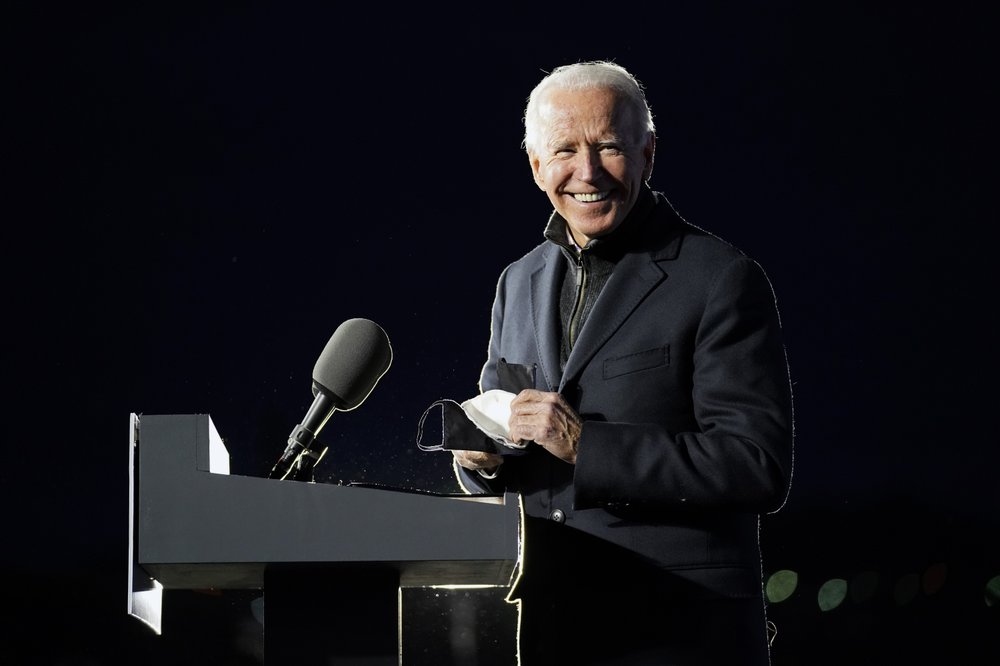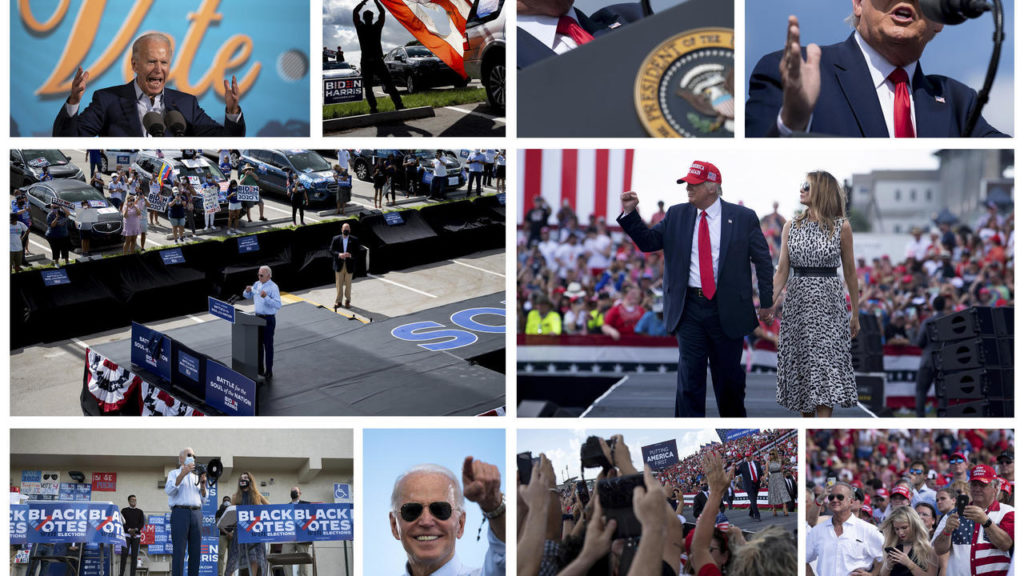
President Trump heads into the final, frenetic 48 hours of campaign 2020 having lost ground among key groups that powered his drive to the presidency four years ago, the final USC Dornsife poll of the election shows.
Former Vice President Joe Biden leads Trump by double digits nationally — 54% to 43% in the poll’s daily tracking, a margin that has remained almost unchanging since summer. Biden’s support has ticked down just slightly from the high it reached after the first debate between the two candidates in late September; but overall, the poll has barely budged since USC began its daily tracking of the race in August.
That’s consistent with most other major surveys. The final NBC-Wall St. Journal poll of the campaign, for example, shows Biden leading 52% to 42%, a result nearly identical to what that survey found in January.
“So much has happened in the past 10 months of this year — impeachment, George Floyd’s murder, Black Lives Matter, fires and floods, RBG’s death, and yet the presidential trial heat has not changed,” veteran Democratic pollster Peter Hart, who oversees that poll with Republican pollster Bill McInturff, wrote in an email. “The voters know the stakes, they care and they have been very consistent and constant in their vote since January.”
Another key measure has also remained extremely stable — the images of the candidates. Just over half of voters, 51%, have a favorable view of Biden, compared with 47% who view him unfavorably, the poll found. Trump’s image remains deep underwater: 59% see him unfavorably, including 48% who have an extremely unfavorable view, compared with 39% who see him favorably.
Biden’s relative popularity stands in sharp contrast to 2016, when majorities had unfavorable impressions of both Trump and Hillary Clinton.

The poll’s main measure of support for the candidates asks voters to use a 0-100 scale to give the probability that they’ll vote for either candidate as well as the probability that they’ll vote at all. A separate experimental question asks voters how they think their friends, neighbors and other members of their social circles will vote. That question yields a smaller Biden lead, 51% to 46%.
The difference between the results could reflect a reservoir of hidden Trump support that the regular poll question doesn’t pick up. The result also could reflect voters overestimating how much people they know support Trump, perhaps as a result of his unexpected victory in 2016.
Trump had an opportunity to change the race this spring, when the coronavirus hit, said Bob Shrum, the Democratic strategist who directs USC’s Center for the Political Future, which co-sponsors the poll.
“It could have gone either way” at that point, Shrum said. If Trump had handled the pandemic in a way that reassured the public, he might have enjoyed a rally like those that leaders of many other governments have received. Instead, “the way he handled it brought him back to the problems he had all along.”
The pandemic has remained a center of voters’ attention throughout the year. The economy and the coronavirus consistently have been the two topics voters cite most when asked which issue was most important to them. The share of voters citing the pandemic as their top issue has risen from 13% in August to 18%.
“Both campaigns have narrowed the focus” in the closing weeks to those two issues, limiting discussion of other topics, which have declined as voter concerns, said Jill Darling, the director of the USC survey.
Trump, for example, tried during the summer and early fall to focus voters on law and order but never gained traction. In August, the USC poll showed 10% of voters listing law enforcement and criminal justice as their top issue. By this final poll, that share had dwindled to 7%. Among Republicans, the share has dropped by 7 points.
Another issue that Republicans hoped might help them, Supreme Court appointments, was cited by just 3% of voters as their top issue. Only 2% cited immigration, an issue that dominated the 2016 campaign but which Trump has downplayed in his reelection bid after it failed to help him during the midterm elections in 2018.
Among Democrats, meanwhile, racial unity has declined 9 points as a top issue since the summer, with COVID rising an equal amount.
Trump has retained a 53% to 47% lead on which candidate voters think would make the best decisions about the economy. But voters’ disdain for his handling of the coronavirus has outweighed that. Biden leads on that issue, 59% to 41%, a slight expansion of the 14-point lead he held in August.
The basic structure of this election took shape even before the Democrats started their primaries. In the midterms, a wave of suburban voters rejected Trump and swept Democrats back into control of the House with victories in longtime Republican districts in places like Orange County and the suburbs of Philadelphia.
Overall, suburban counties went from Republicans having an advantage of 1.2 million votes in 2016 to Democrats winning by 2 million in 2018, according to a new analysis by William Frey, a demographer at the Brookings Institution in Washington.
That wave has continued to strengthen this year, and both sides expect Democrats to pad their House majority. Districts in the suburbs of Houston, Dallas, Omaha, Indianapolis and Atlanta could all flip.
On the presidential level, Trump’s challenge can be seen on two measurements — the size of the turnout and a decline in his share of the vote among key groups.
A surge of college-educated white voters played the lead role in the suburban revolt against Trump in the midterms, and so far, that surge has continued. Among the more than 93 million Americans who already have voted, college-educated white voters made up 31% of the turnout as of Sunday morning, according to data from TargetSmart, a Democratic vote-analysis firm. That’s up from 27% of the early turnout in 2016.
Biden leads among people who said they had already cast ballots by 64% to 32%, the USC poll found.
That big margin so far is no surprise: Trump has urged his supporters to avoid the mail and show up on election day, and about half the people in the poll who said they plan to vote Tuesday are Republicans or Republican-leaning independents. Trump’s hopes lie in a surge from those voters.
That could still happen in battleground states like Pennsylvania, North Carolina, Florida and Arizona, which remain closely contested. Trump trails in each of those states, according to polling averages, and he would have to prevail in all of them and more to win.
The central problem for Trump is that he can’t count on repeating the outsize margins he ran up in 2016 among his core groups, the USC poll indicates.
Compared with the final USC poll four years ago, Trump has lost 4 points among all voters 65 and older, for example. That’s a group that made up more than a quarter of the electorate in 2016, according to data from the non-partisan Pew Research Center. Trump’s lead among seniors played a big role in his 2016 victory, but Biden currently leads among them by 52% to 46%, the poll found. Biden has a larger lead, 56% to 37%, among voters younger than 35.
The poll found a significant erosion of Trump’s backing among white voters who did not graduate from college — the core of his support. Compared with 2016, his vote is down 6 points among white women without a degree and 5 points among white men without a degree.
Some surveys have shown Trump partially offsetting losses among white voters by gaining ground among Latinos. Others, including the USC poll, do not show a Latino gain for Trump nationwide. Latino voters could play a key role in several contested states, including Florida, where Trump clearly has made some gains, Texas, Arizona and Nevada.
The question of how much, if any, gain Trump has made among Latinos won’t be resolved until detailed post-election data become available. But even if the gains are real, Latinos make up slightly more than 10% of the nation’s voters, so marginal gains in that group won’t help Trump offset losses among white voters, who made up about 74% of the electorate in 2016, according to Pew’s data.
The USC Dornsife poll four years ago showed Trump winning the nationwide vote, which he lost to Clinton by just over 2 percentage points. After the election, USC analysts found that the poll overestimated Trump’s vote because it had too large a share of rural voters. The 2016 numbers used in this comparison come from a post-election USC poll, re-weighted to correct that error.
The poll, a joint project of the university’s Center for Economic and Social Research and the Center for the Political Future, tracks the views of a panel of more than 8,000 eligible voters, surveying each panel member every 14 days. The current results are based on responses between Oct. 20 and 31 from 3,647 likely voters. Early-vote results are based on 2,410 respondents who reported that they had already voted.
Results are weighted to reflect U.S. Census Bureau figures for demographic characteristics including gender, race, education and the 2016 vote. The estimated error range for the poll’s full sample is roughly 2 percentage points in either direction; for early voters, it is 3 points.
A complete description of the poll’s methodology, along with the text of the questions asked and the full data tables, is available on the USC Dornsife website.
Yahoo News
This story originally appeared in Los Angeles Times.

Leave a Reply
You must be logged in to post a comment.